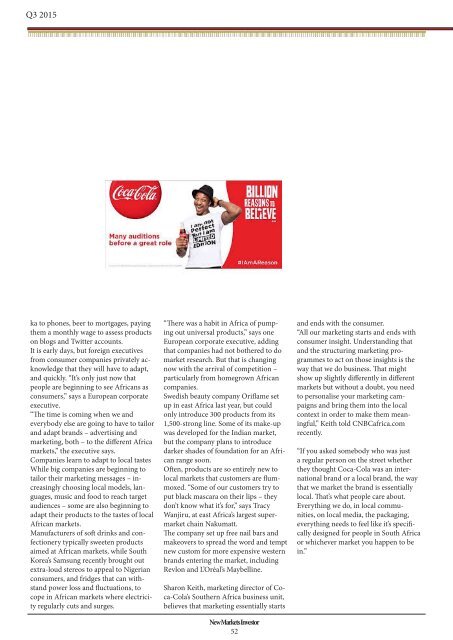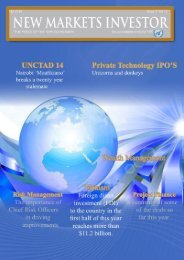New Markets Investor
Published by The Media Corporation
Published by The Media Corporation
Create successful ePaper yourself
Turn your PDF publications into a flip-book with our unique Google optimized e-Paper software.
Q3 2015ka to phones, beer to mortgages, payingthem a monthly wage to assess productson blogs and Twitter accounts.It is early days, but foreign executivesfrom consumer companies privately acknowledgethat they will have to adapt,and quickly. “It’s only just now thatpeople are beginning to see Africans asconsumers,” says a European corporateexecutive.“The time is coming when we andeverybody else are going to have to tailorand adapt brands – advertising andmarketing, both – to the different Africamarkets,” the executive says.Companies learn to adapt to local tastesWhile big companies are beginning totailor their marketing messages – increasinglychoosing local models, languages,music and food to reach targetaudiences – some are also beginning toadapt their products to the tastes of localAfrican markets.Manufacturers of soft drinks and confectionerytypically sweeten productsaimed at African markets, while SouthKorea’s Samsung recently brought outextra-loud stereos to appeal to Nigerianconsumers, and fridges that can withstandpower loss and fluctuations, tocope in African markets where electricityregularly cuts and surges.“There was a habit in Africa of pumpingout universal products,” says oneEuropean corporate executive, addingthat companies had not bothered to domarket research. But that is changingnow with the arrival of competition –particularly from homegrown Africancompanies.Swedish beauty company Oriflame setup in east Africa last year, but couldonly introduce 300 products from its1,500-strong line. Some of its make-upwas developed for the Indian market,but the company plans to introducedarker shades of foundation for an Africanrange soon.Often, products are so entirely new tolocal markets that customers are flummoxed.“Some of our customers try toput black mascara on their lips – theydon’t know what it’s for,” says TracyWanjiru, at east Africa’s largest supermarketchain Nakumatt.The company set up free nail bars andmakeovers to spread the word and temptnew custom for more expensive westernbrands entering the market, includingRevlon and L’Oréal’s Maybelline.Sharon Keith, marketing director of Coca-Cola’sSouthern Africa business unit,believes that marketing essentially starts<strong>New</strong> <strong>Markets</strong> <strong>Investor</strong>52and ends with the consumer.“All our marketing starts and ends withconsumer insight. Understanding thatand the structuring marketing programmesto act on those insights is theway that we do business. That mightshow up slightly differently in differentmarkets but without a doubt, you needto personalise your marketing campaignsand bring them into the localcontext in order to make them meaningful,”Keith told CNBCafrica.comrecently.“If you asked somebody who was justa regular person on the street whetherthey thought Coca-Cola was an internationalbrand or a local brand, the waythat we market the brand is essentiallylocal. That’s what people care about.Everything we do, in local communities,on local media, the packaging,everything needs to feel like it’s specificallydesigned for people in South Africaor whichever market you happen to bein.”









